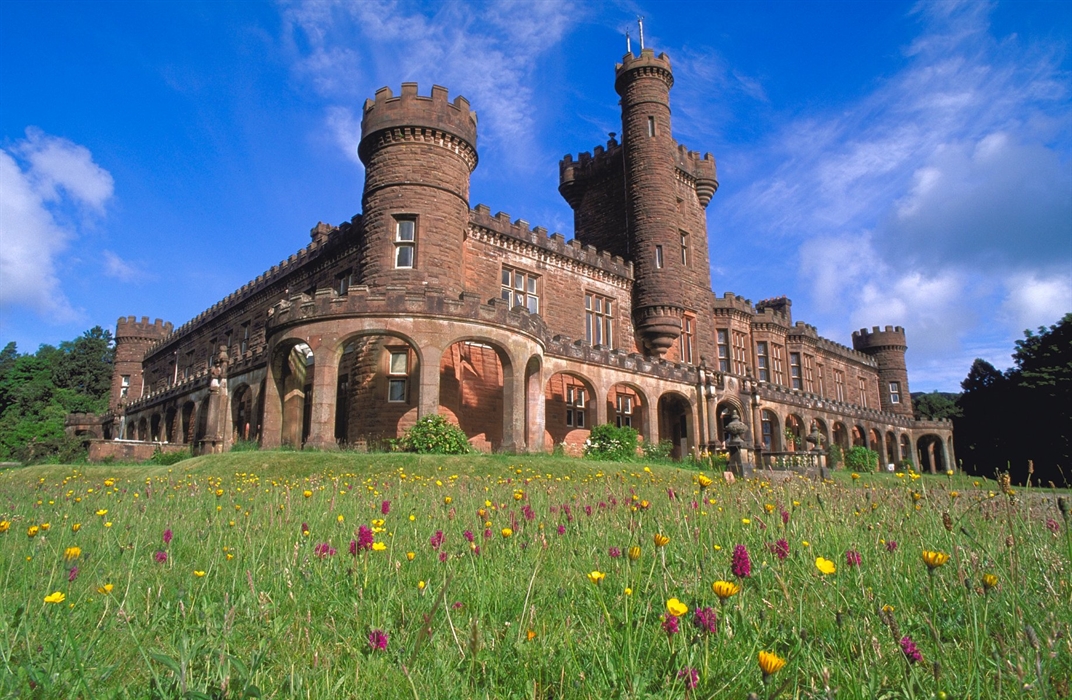Continuing our look at the wee western isles of Scotland
The Isle of Rum in Scotland’s Inner Hebrides, amazing wildlife, an eccentric castle, walks to suit all levels, beautiful beaches and stunning scenery. Rum is a short ferry from either Arisaig or Mallaig – visit for a few hours, soak up the atmosphere and still have time for a bite to eat in the village hall tea shop. For the adventurous take in the stunning mountain and coastal scenery, spectacular wildlife including eagles, shearwaters, red deer and the hardy Rum ponies. For guided walks, have a look at our Community Ranger Section. The Isle of Rum is part of the small isles national scenic area, a special protection area for birds, a site of special scientific interest. The island also has 17 nationally important ancient monument sites, 2009 /10 saw the phased transfer of land and assets in and around Kinloch Village from Scottish Natural Heritage (SNH) to Isle of Rum Community Trust ownership. This is giving the community and individuals control over their own destinies and creating unique, exciting opportunities for locals and people who would like to come and live here.
No visit to Rum is really complete without a visit to Kinloch Castle. Visit this amazing Edwardian time, tours take approximately 45 minutes and start from the steps at the front of the castle.
HISTORIC MENTIONS … Mesolithic – middle stone age – settlement located at the edge of Kinloch on the north shore of Loch Scresort. Discovered by Caroline Wickham-Jones during the 1984-86 archaeological dig for Historic Scotland. This has been identified as one of the earliest human settlement site in Scotland. Over 100,000 artefacts were found at this site implying that it was used on and off over a thousand years. 1300’s AD Angus Og, a direct descendent of Somerled was rewarded for his loyalty in the Battle of Bannockburn (1314) and was given land in the west highlands and islands. His son declared himself Lord of the Isles and in turn his son, Ranald (Clanranald chieftain) inherited lands including Rum and Eigg. Moving to 1499 AD, John Garbh son of a chief of the Macleans of Duart on Mull demanded an inheritance from the 3rd Lord of the Isles – he received the island of Coll. Legend has it that he gained Rum from Clanranald for the price of a good-looking, but rotten galley. He then held Clanranald prisoner on Coll until the dispute was resolved in his favour. Rum had been ransacked and ravaged many times by the warring clans. 1580 AD, King James VI quelled the violence in the Hebrides and set out to have all lands surveyed. Rum at this time only had two settlements with few inhabitants. In its favour, Rum was observed to have a good population of deer. 1800 AD, the tenants of Rum are in severe rent arrears to their landlord Maclean of Coll, who himself was in dire financial straits after buying the island of Muck. The Macleans’ leased Rum to Dr Lachlan Maclean (a relation from Coll) as a sheep-walk. All available land would be required to graze the 8000 head of sheep. 1845 AD Rum put up for sale by 16th and last Maclean of Coll. Rum bought by 2nd Marquis of Salisbury hoping to transform Rum into a Victorian Highland sporting estate. 5000 sheep still grazing Rum and shepherds bothies built around the island. Fallow and Red deer introduced. Red deer numbers grew quickly as more red deer were introduced from both Scottish and English estates.
The Rum visitor centre is situated on the lower shore road near the old pier. Here you can learn about the island’s special features, the walking opportunities and pick up information leaflets. There is also information on fishing – a leaflet showing the designated fishing lochs, and a form to fill in details of your catch. Rum has much to offer in the winter as well as the summer: midge-free from October to May. Red deer stags are often seen around the village, oonly disappearing briefly for the rut from September to November. Seals, otters and feral goats are seen closer to the village from November to April, possibly due to there being fewer people about. Golden and white-tailed eagles, Oystercatchers, Curlews, Red breasted Mergansers and Eider ducks are here all year. Ranger wildlife walks, talks and wild food foraging expeditions are available all year round. You can forage for plants and seafood; learn about the history of Rum; visit croft ruins and ancient graves; sample local food and crafts; go fishing and hire (or bring) bicycles for a cycle ride to see Rum’s breathtaking beaches.
HOW TO GET THERE … The MV Loch Nevis sails from Mallaig to Rum five times a week in summer and four in winter. A leisurely day trip will allow a short stop for a cup of tea and a gentle stroll. Have a look at the CalMac website for timetable information. From further down the coast at Arisaig, Marine MV Shearwater runs from Arisaig on twice a week (summer only) offering 2-3 hrs ashore on Rum. Times are flexible as this is also a wildlife and cetacean watching cruise and the boat may be lead off at a tangent by basking sharks, dolphins or minke whales.
So there you have it, Rum in a nutshell. A day trip would be our suggestion from either location above. Of course we (MCLEANSCOTLAND) can arrange all this for you as a part of your Scottish tour with us of our west coast.

